Utterly private and exceptionally spacious, it’s been called the best seat on board — and it’s not even in first class. Recently, on a quick New Year’s Eve getaway to Paris, I took the chance to experience SWISS Global Airlines’ so-called business class throne seat.
SWISS’ unique staggered business class configuration is a double-edged sword of sorts. While groupings of side-by-side window-aisle seat pairs leave window passengers stranded, the single seats that parse them are plush and doubly spacious.
These so-called throne seats are coveted, so much so that SWISS charges business class passengers a fee to select them more than 48-hours in advance. I paid no such fee, however, opting instead to play the waiting game in hopes that at least one of these plush beauties would remain open.
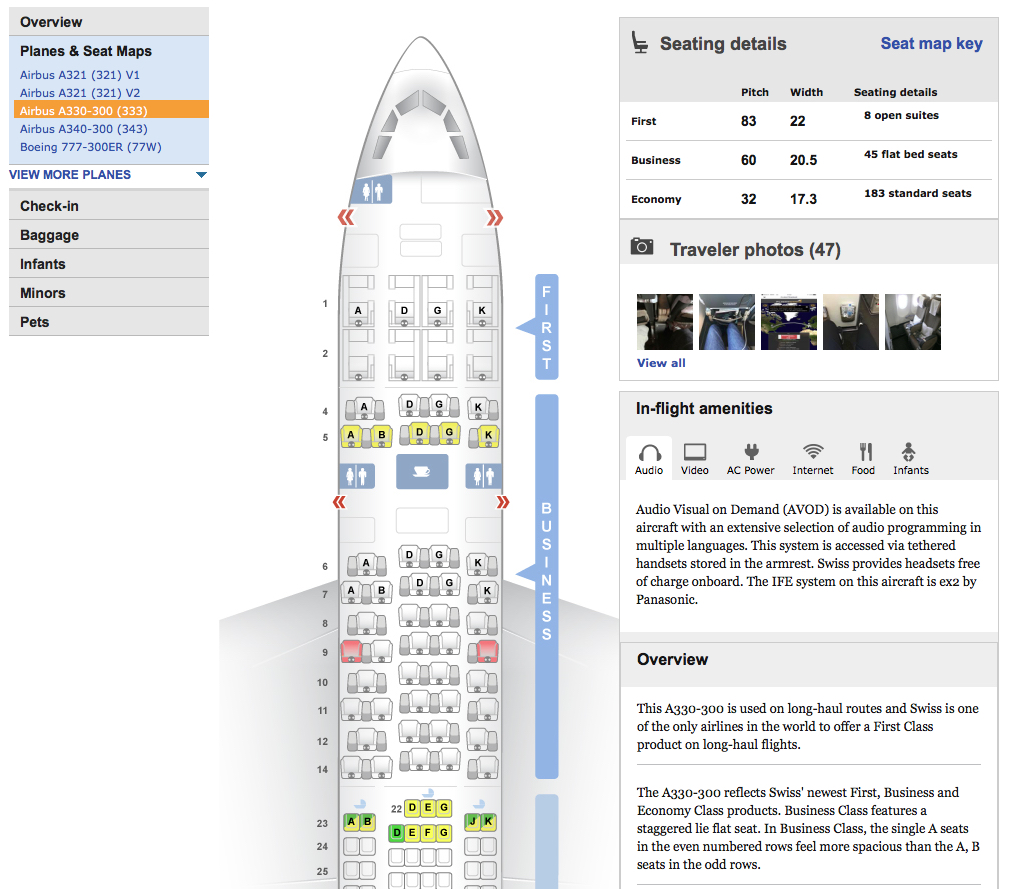
Throne seats on the A330 are the solitary ‘A’ seats on the port (left) side of the aircraft, between the paired seats. Source: SeatGuru.com
SWISS operates two aircraft on long-haul international flights, the Airbus A330 — which has long been the workhorse of the SWISS fleet — and a sparkling new ensemble of Boeing 777-300ERs. Objectively, the 777-300ER is a newer, nicer aircraft. It’s wider, taller, quieter, more fuel efficient and more advanced. I even tend to think the 777 cabin smells better when loaded to capacity than that of the A330.
I chose to fly a more convenient Chicago routing on the A330, though. Nothing about an A330 makes me unhappy, and if I were travelling in economy I would vastly prefer the Airbus’ 2-4-2 seating configuration over the 3-4-3 crushload on the new 777s. All SWISS A330s have been retrofitted and standardized to match the new 777s asthetic and entertainment/connectivity options.
Booking the award.
The easiest way to search for SWISS availability, in my opinion, is using the United Airlines website. SWISS Air flights show up fairly reliably on United.com. The site doesn’t require a log-in to use and allows easy cross-date comparisons.
SWISS usually makes transatlantic business class awards available to partners within about two weeks of departure, but awards do occasionally show up sooner. If you are having trouble finding award space for your trip, or don’t have time to search, try using an award planning service like Juicy Miles.
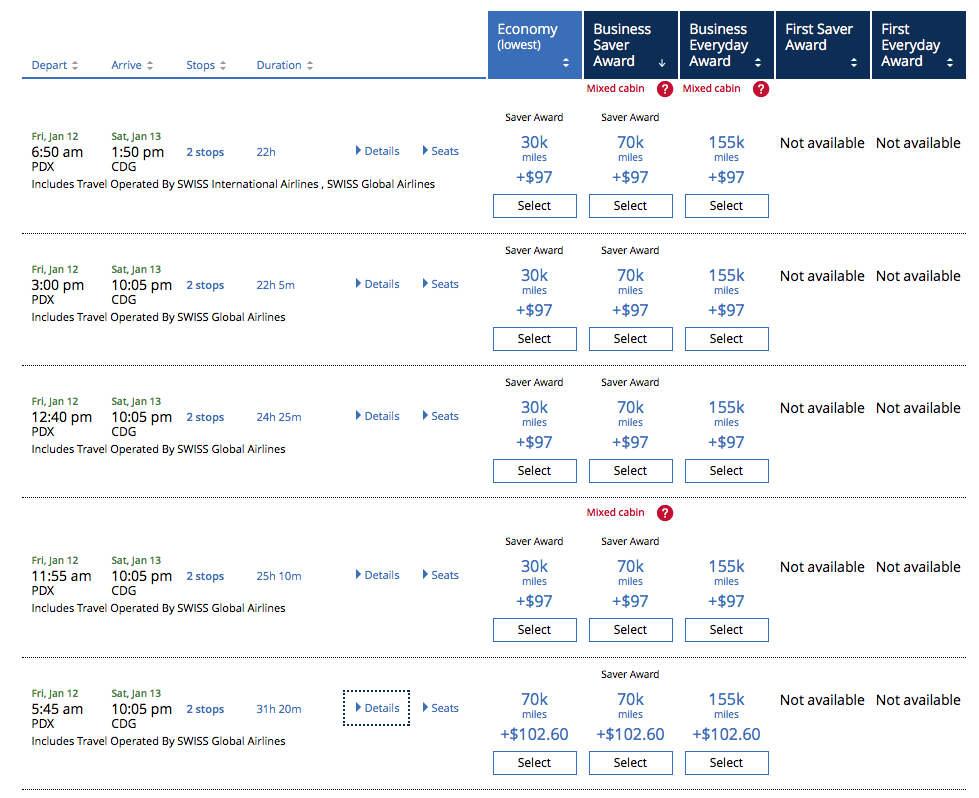
Searching for SWISS award space using United.com is fairly easy. SWISS Global Airlines tends to be one of the last Star Alliance carriers to release award space, though, so don’t expect to see too many swiss flights up until about two weeks before departure.
I booked my flight, a 7:15 p.m. Chicago O’Hare (ORD) departure to Zürich, about two weeks prior to departure for 70,000 Chase Ultimate Rewards points, transferred to my United MileagePlus account.
Thanks to Premier Platinum status I paid just $21.60 in fees. Without said status I would have faced an additional $75 fee for booking the award within three weeks of departure.
I could also have booked this award by transferring 55,000 American Express Membership Rewards points to Aeroplan, or 63,000 Citi ThankYou points to Avianca. Chase and AMEX points can also be transferred to Singapore Airlines, which charges 65,000 points for this award.
I chose United for the convenience of online booking and to avoid higher fees.
The absolute cheapest option to book this award — as part of a round-trip — is using AMEX Membership Rewards transferred to ANA Mileage Club. ANA charges 44,000 each-way for this business class award. Again, this can only be booked as a round trip.
Lufthansa and SWISS’ Miles and More program charges 52,500 miles for this flight, and is a Starwood Preferred Guest transfer partner.
Checking in.
I was connecting from a domestic Delta flight (off a much-needed end-of-year mileage run) to Chicago O’Hare’s orphaned international terminal. As Delta and SWISS have no codeshare agreements to facilitate baggage transfers, this inconvenience created two options:
Option One: I could exit O’Hare’s domestic terminal complex, take an air train to the international terminal, check my baggage at SWISS’ Business check-in, and traverse security without TSA Precheck.
Option Two: I could forego checked baggage, check-in online, and transfer to my SWISS flight without leaving security by taking a shuttle bus from American Airlines Terminal 3, gate G20 or K17.
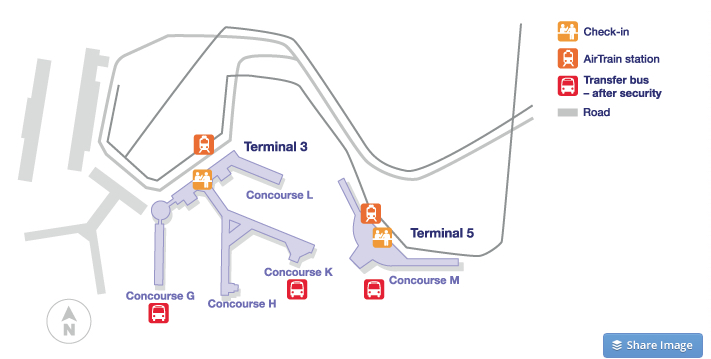
Chicago O’Hare’s Terminal 5, a.k.a. the international terminal, is a pain to get to. This map shows shuttle bus connections from Terminal 3.
Given my disdain for redundant security screenings — and really any TSA experience that is not Precheck — I chose the second option.
SWISS’ website rejected United’s reservation code, but accepted the e-ticket number, which I found on my emailed receipt from United. Check-in was intuitive, I was able to select my coveted throne seat for free, and an Apple Wallet boarding pass was delivered to my iPhone via text. No muss, no fuss.
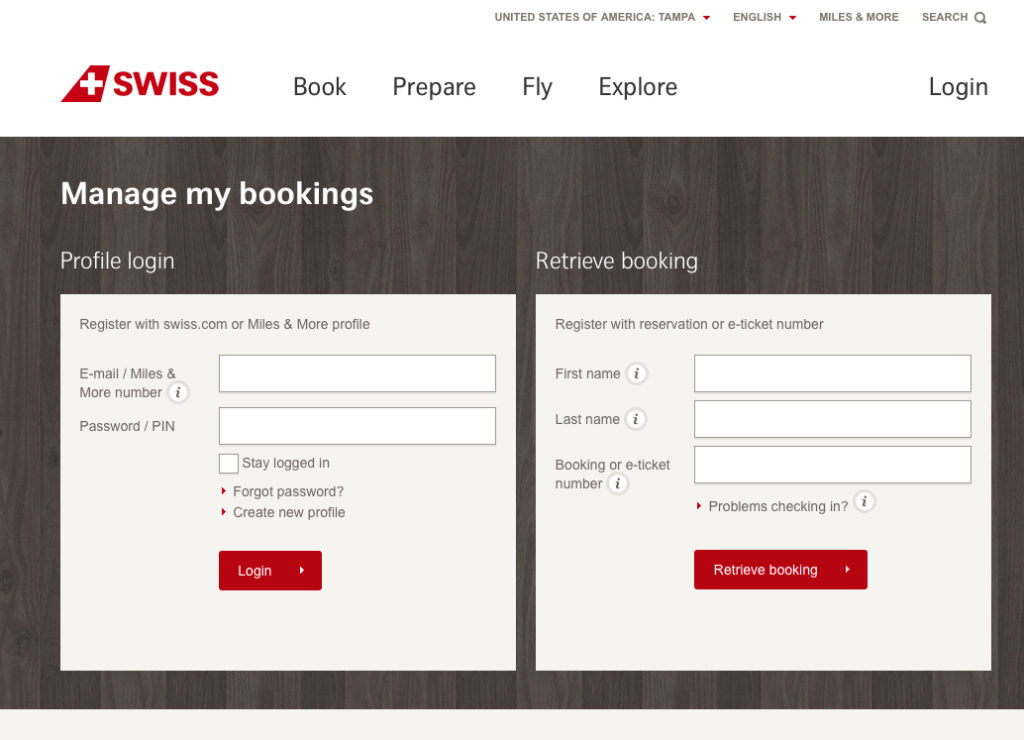
The most difficult part of my SWISS Air journey? Finding the online check-in screen. It takes three clicks to get here, for some reason (prepare, online check-in, and then another button for online check-in). You’ll need to use the ticket number, not reservation code, when looking up a Star Alliance partner award.
Be prepared to present both passport and boarding pass at the shuttle bus, which is accessible to any passenger with a flight departing from O’Hare’s Terminal 5.
The bus itself is a rather strange experience. There is no dedicated bus entrance, so passengers line up in a queue and are escorted by airport ramp personnel down a set of jetway stairs to the tarmac and back. The bus itself is not operated by an airline, but by the Chicago Department of Aviation. While better than having to re-enter security, this has to be one of, if not the worst airport transfer experience in the first world.
As we approached the international terminal, the driver and ramp worker onboad were surprised to find a Lufthansa A340 pulled up to the gate where they had anticipated dropping us off. It required another 10 minutes, as we all sat in frigid Chicago December cold, to figure out where the bus could go. We were eventually walked up the jetway stairs two gates down. Sheesh.

My boarding pass, delivered directly to my phone without having to see a gate agent. The ability to check-in online, with passport details, definitely saved me in this tight-connection scenario.
At the terminal.
Unfortunately, due to a two-hour ground delay on my incoming flight, I had no time to explore either the Chicago United Polaris lounge or the SWISS Business Lounge, which is just a few dozen yards from SWISS’ preferred gate space at the international terminal.
When I say preferred gate space, I mean perhaps the best gate in the terminal. My flight departed from gate 11, which was central, right near the lounge, security checkpoint entrance and duty-free shop.
Due to my delay, and the kerfuffle involving the transfer bus, I was among the last few passengers to board.
The gate agents were exceptionally warm and accommodating (“Mr. Harper, good to see you, we’ve been expecting you, welcome aboard”). There was no line on the jetway and I was able to take a quick right, directly into seat 6A, the bulkhead throne seat.
The seat.
Upon taking my seat, I was almost overwhelmed by the amount of personal space at hand. Within reach I had room to comfortably store my shoes, set down my bag before take-off, hang up my coat and stash a thick pillow and comforter.
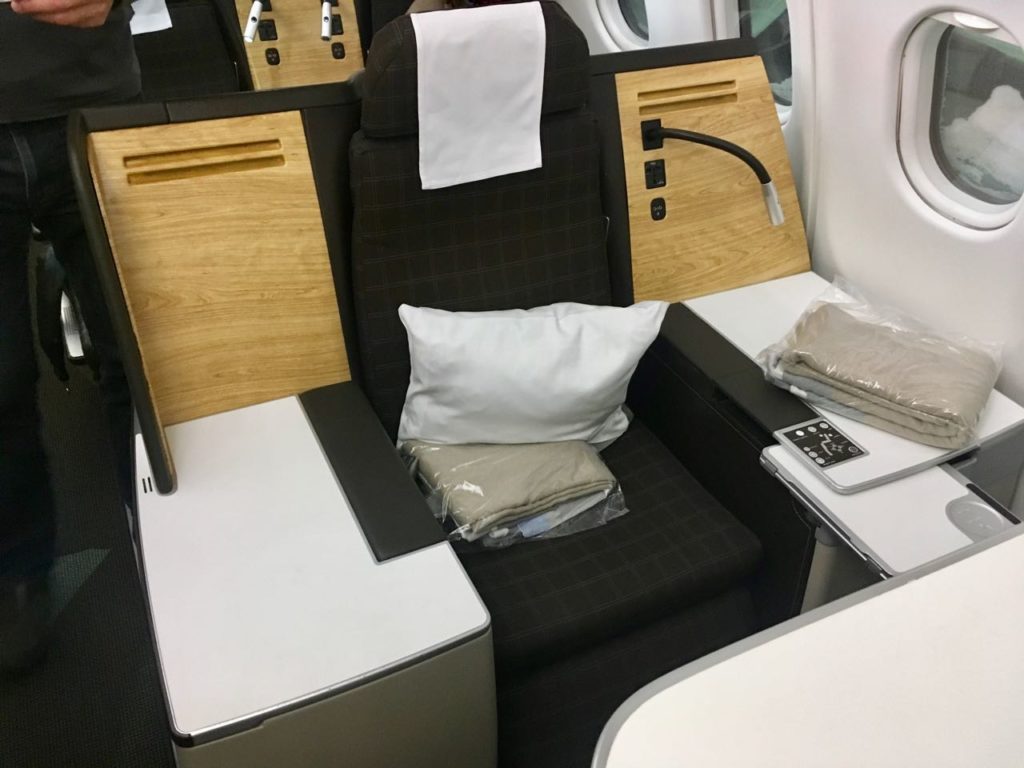
My throne for 8 hours.
With wood-finished table space to my left and right, I was left with a conundrum of organization. Should I set up my office to the left of me, with a laptop on my left and champagne on the right, or should the laptop go on the pivoting tray table, which could be swivelled and moved around to a variety of different heights and positions. Perhaps I could stash a small library collection to one side, and an art collection to the other.
The amount of table space and floor space in this seat is easily comparable with many first class product, and likely surpasses first class seats remaining in the American Airlines and United fleets.
There were other small touches as well. Each seat came with a coat hanger, which flight attendants promptly retrieved once I hung my coat.
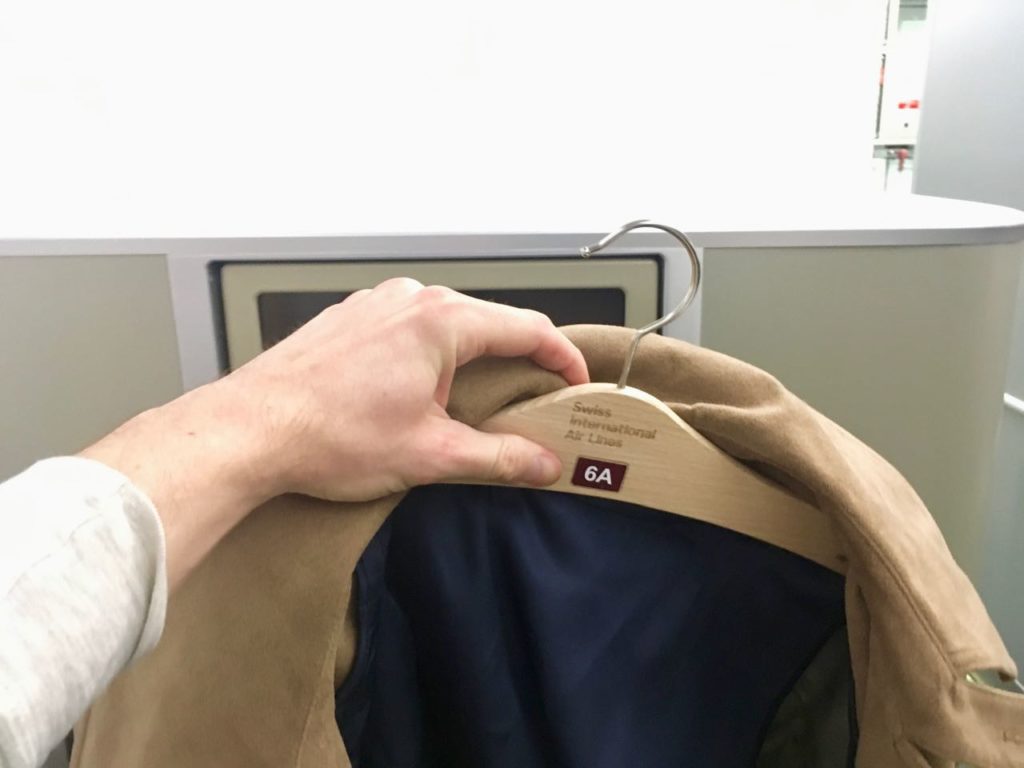
Seats came with their own coat hangars, meaning I didn’t have to so much as hold my coat in my lap or on one of three storage tables.
Bulkhead business class seats often afford exceptional footwell space. These were no exception. Unlike many business class seats, I was able to use the deep footwell for stowage during takeoff and landing. I could not physically reach the back of this footwell in a seated position. In flat-bed recline, the well was in no way constrictive. My size 14 feet fit with room to spare when I was lying flat, on either side, and even when I spread my feet apart.
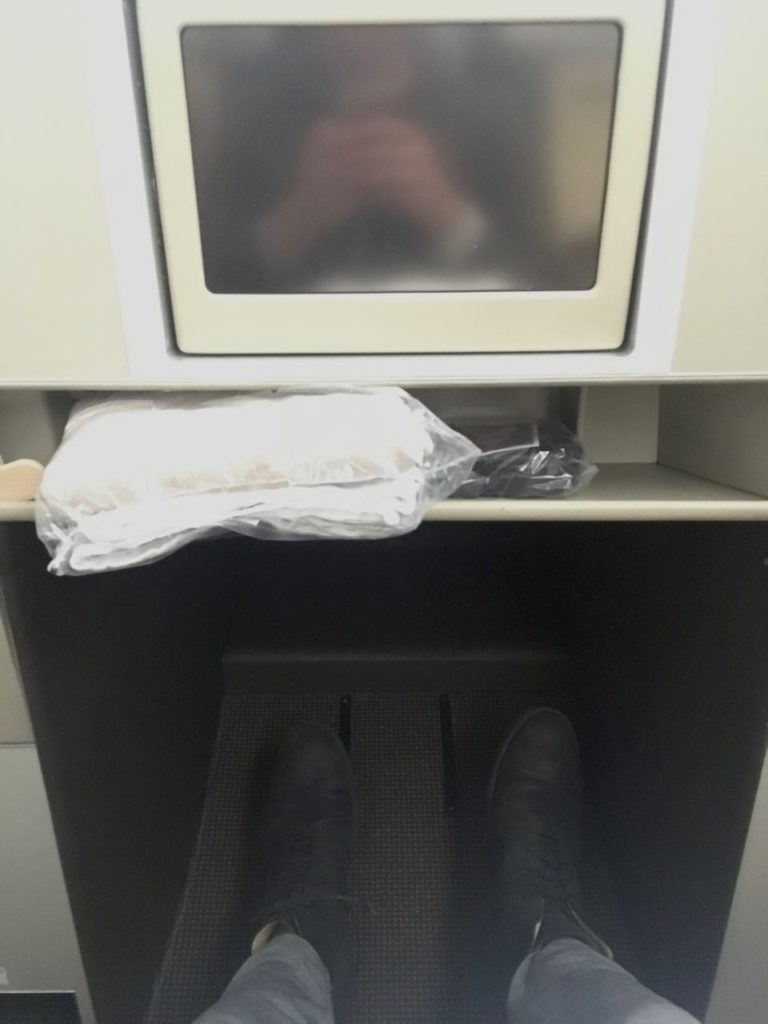
This footwell was among the largest I’ve seen in business class. It could also be used for stowage during takeoff and landing, a rarity among business class seats.
The seat itself was adequately wide, at 21 inches, and was pitched at 80 inches. When fully flat, the bed works out to about 6 feet, 6 inches, though my bulkhead bed felt a bit longer. The seat featured a message function, four-way adjustable lumbar support, and three general seating positions.
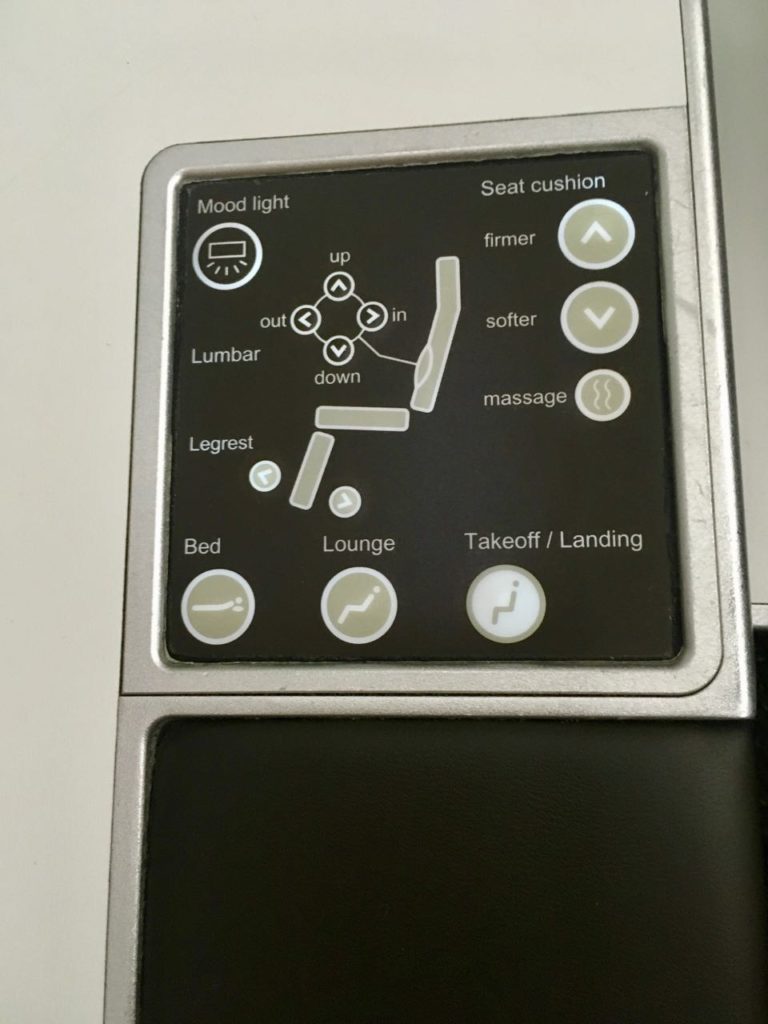
Seat controls were simple enough.
The seat would move to default take-off/landing, lounge and bed modes, but would stop at any point between whenever the button was released. Each business class seat had one universal power outlet and an adjustable, dimmable reading lamp.

Each business class seats had a personal reading lamp and universal power port.
The one disappointing aspect of this seat was sleeping comfort. While it was not constrictive, there were several hard places on the sleeping surface that became more noticeable as time wore on. Many business class seat designs seem to do a better job overcoming the gaps between cushions. United’s new Polaris business class seats are notably more comfortable in bed mode, as are the reverse-herringbone seats on American’s 777-300ERs. I even thought my recent DeltaOne sleep on a Delta A330-200 was somewhat more comfortable, even though that seat was not nearly as spacious.
A sleeping pad, like those offered on ANA and Japan Airlines, would have made a tremendous difference.
The amenities.
Amenity kits were handed out inside beanie hats. This was unique, and I much preferred the hat to yet another amenity pouch. It was minus 6 degrees farenheit in Chicago, so I put the hat on immediately.
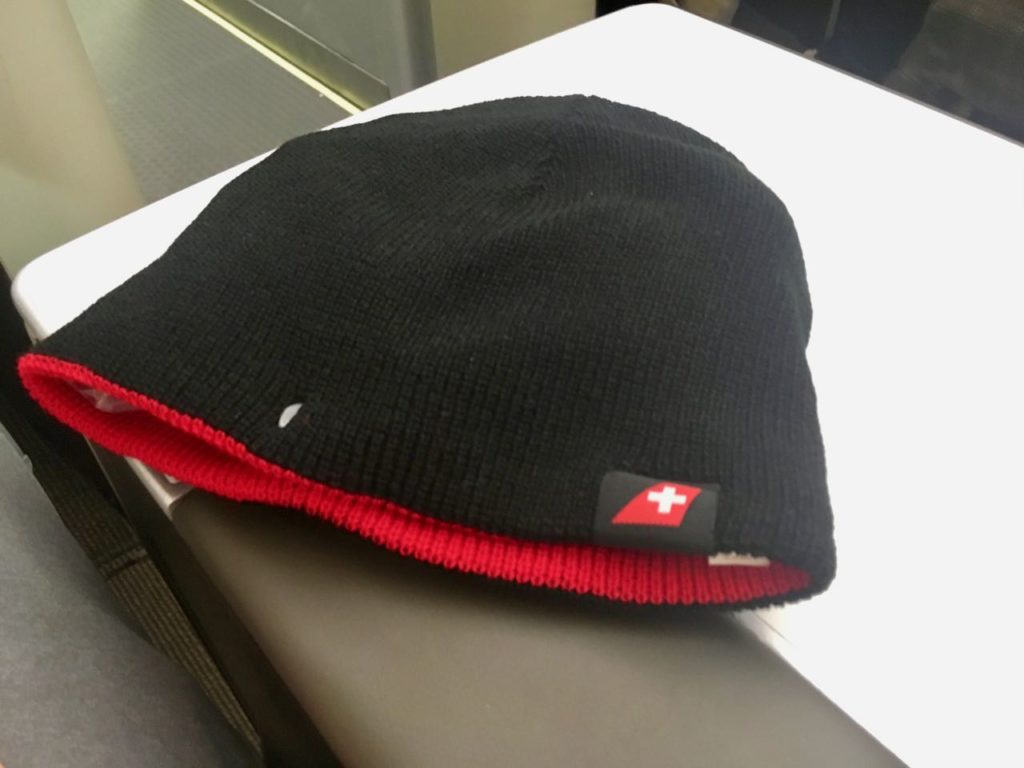
My amenity kit came inside this hat.
The amenity kit was surprisingly simple. It contained chapstick, ear plugs, an eye mask, socks, a SWISS pen, and a toothbrush. I’ve been offered similar amenity kits in premium economy. More cosmetic products were for the taking in the lavatory, though, including a lovely Swisscode facial spray and mini tubes of Swisscode Regenerating Face Moisturizer.
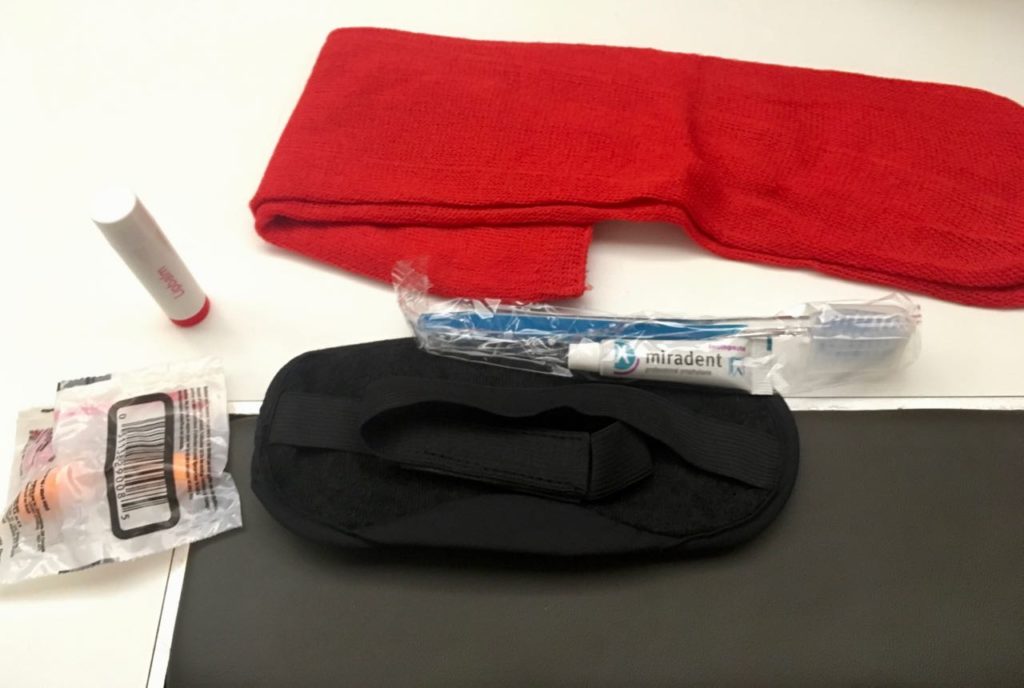
The hat didn’t contain a rabbit, but there were a few odds and ends. This is a rather sparse amenity kit for an international business class flight, but I often find these things excessive.
Each seat also came with a pair of noise-cancelling headphones. They were fine, not great. When sleeping I opted for the earplugs instead.
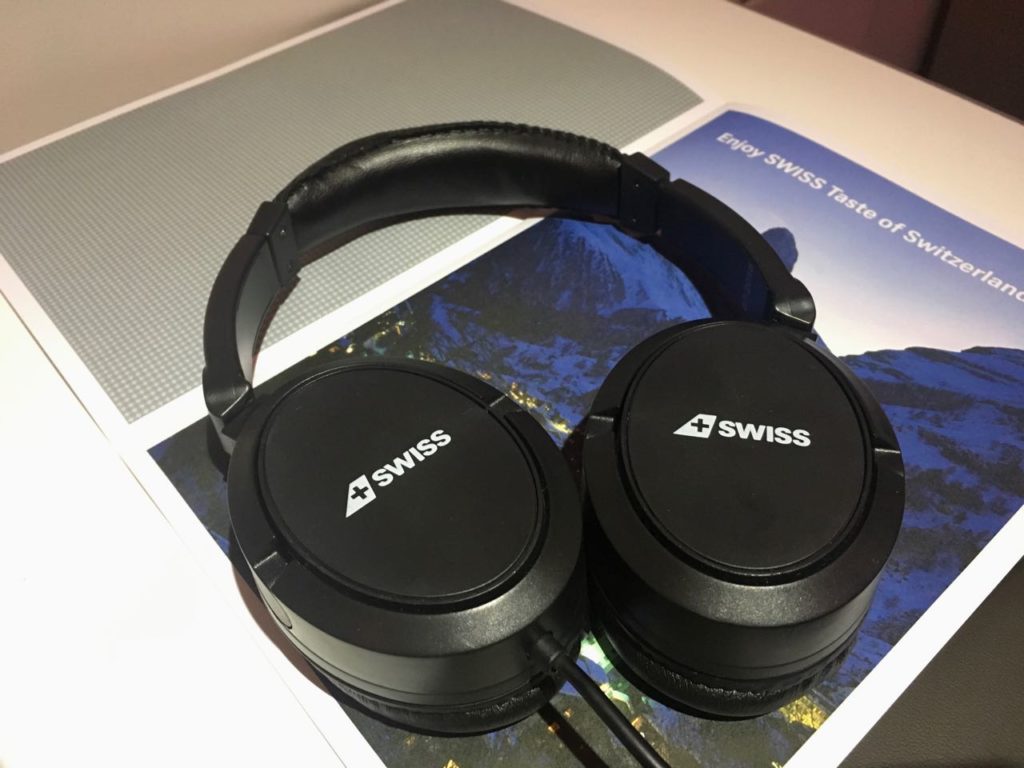
They cancelled noise, sort of.
The meal.
Once on board I was offered a glass of champagne, a customary business class welcome. SWISS serves Duval-Leroy Brut Reserve in business class, not top of the line, but a tasteful pour, balanced and dry.
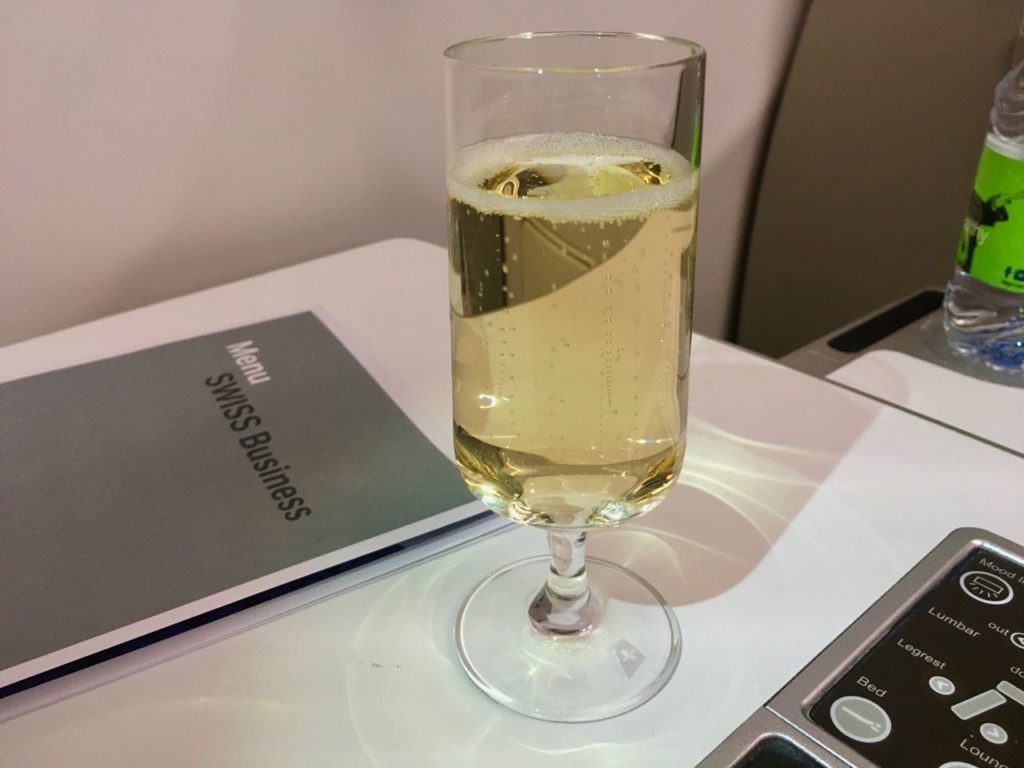
Duval-Leroy champagne was served in glassware.
Service continued shortly after takeoff with the customary towel service and heated nut mix.
SWISS developed its business class dining concept in 2002. The fact that it has persisted so long is a testament to one of the better culinary experiences aloft.
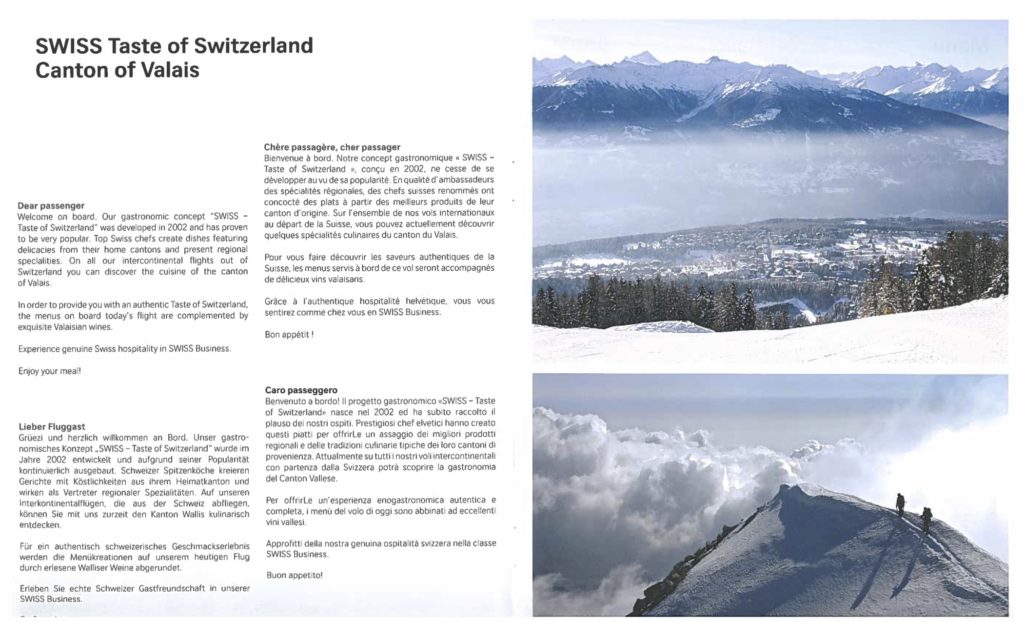
Business class passengers on transatlantic flights are offered a four-course meal, beginning with a comprehensive starter plate. Passengers could choose from three main course dishes.
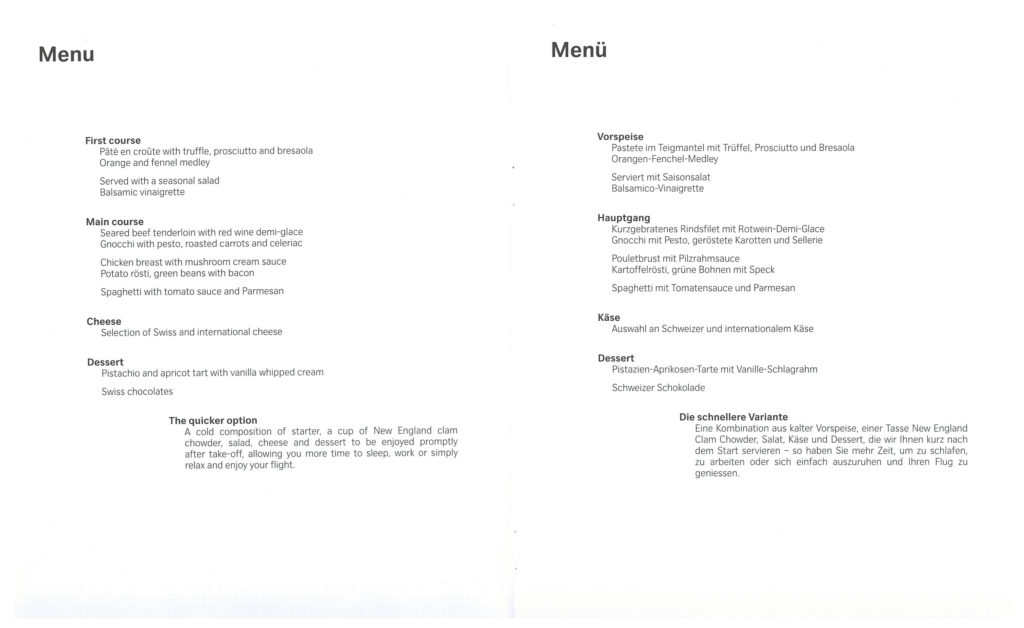
SWISS menus are written in four languages: English, French, German and Italian.
The starter included pate en croute with truffle, prosciutto and bresaola, an orange and fennel medley and a small salad. A selection of breads are served warm.
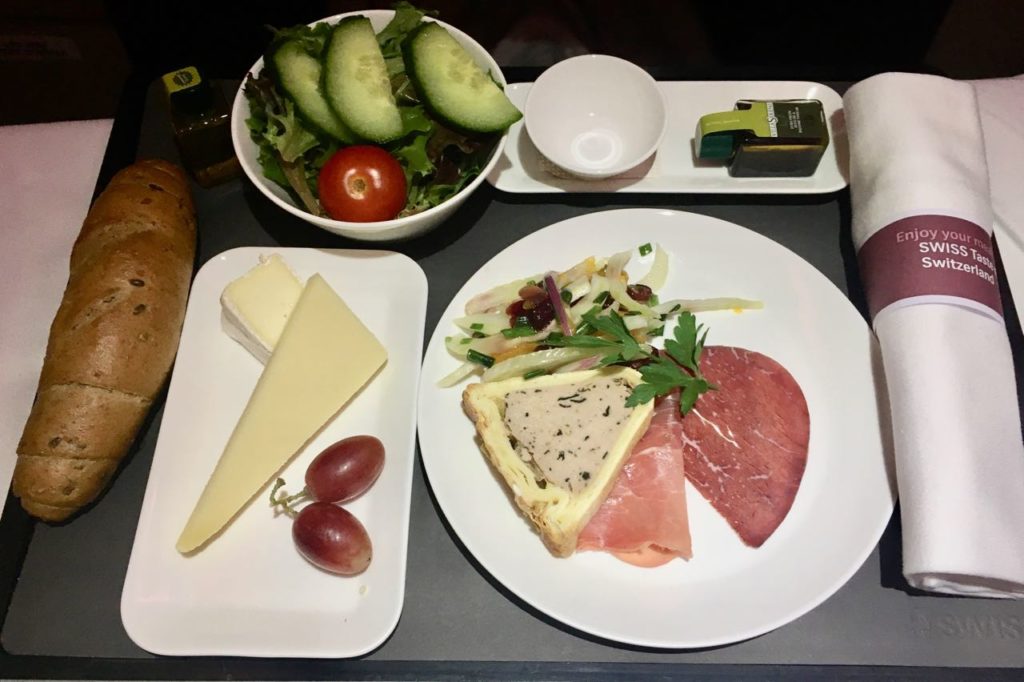
My starter, featuring a few cheeses and a crusted pate. It was lovely. Bread was served in a variety basket.
For the main, I chose the seared beef tenderloin with red wine demi-glace, served alongside pesto gnocchi and roasted vegetables. Four years before my flight, Point Me To The Plane Editor Adam dubbed SWISS’ beef preparation “the best fillet in flight”.
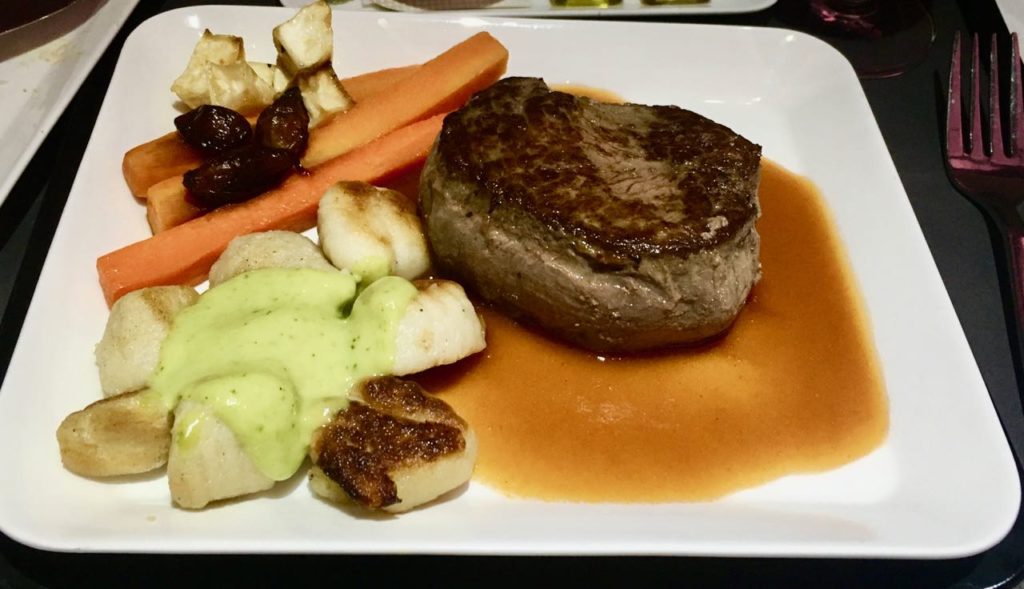
SWISS knows how to serve a steak at altitude, a rare and impressive feat. Gnocchi and roast vegetables on the side were nicely prepared.
As a caveat, I am not an airline food enthusiast, in any class of service. Any food served on an airplane, whether in United economy or Etihad’s residence, is cooked in a catering kitchen at least several hours before it’s eaten — often more. There’s only so much that can be done with reheated meals, and high altitudes don’t provide optimal conditions for gastronomic endeavors, either, as senses of taste and smell tend to fade in thin, dry air.
Given that predisposition, I was downright impressed with what S managed to pull of with this seared beef tenderloin.
The steak was downright tender, and while it clearly wasn’t hot-off-the-stove bleeding, it was still a nice color. The grain of the meat was clearly visible, and believe or not, emitted some remnants of juice.
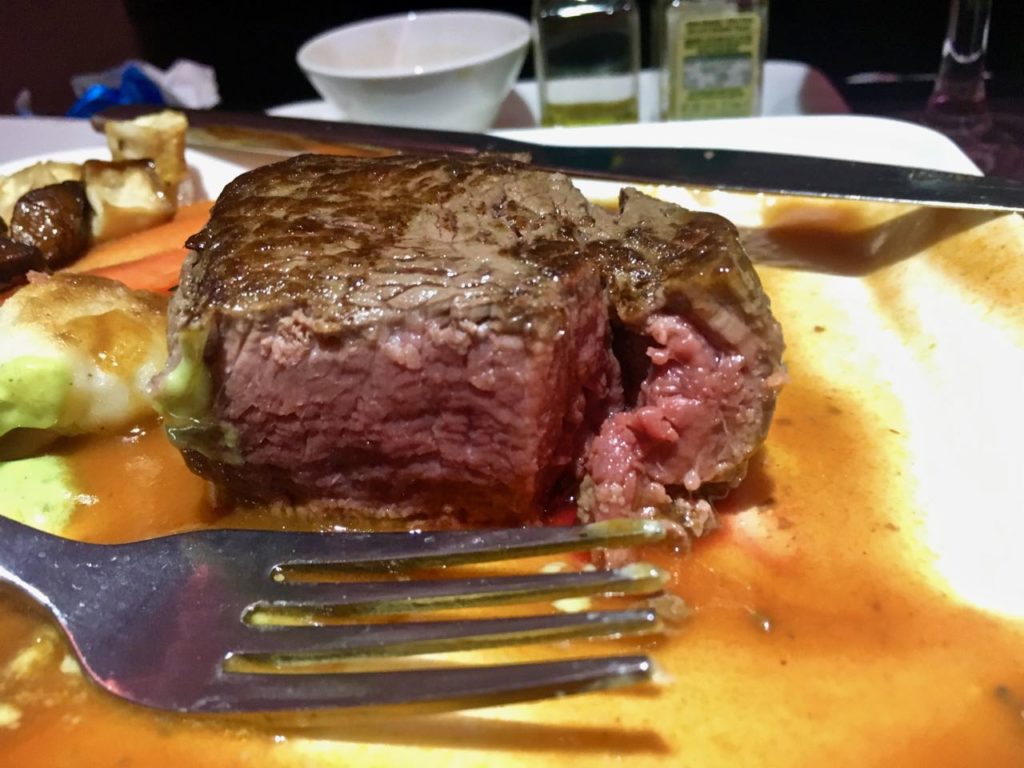
There is actually juicy coming out of this steak, even after it has been boxed up, depressurized and reheated in single-digit humidity. Marvelous.
I’d say, even four years later, WISSSWISS retains the crown of high altitude red meat preparation.
Flight attendants were warm, but service was exceptionally slow on this flight. It took nearly 45 minutes for the first course to be served, another 20 for the plate to be cleared, and at least another 15 minutes for my main course to arrive. By the time my dinner plate was cleared, there were just 5 hours, 30 minutes remaining in the flight.
The wine and alcohol lists were adequate and included a nice selection of aperitif and digestif liqueurs. I was also impressed by the variety of tea served.
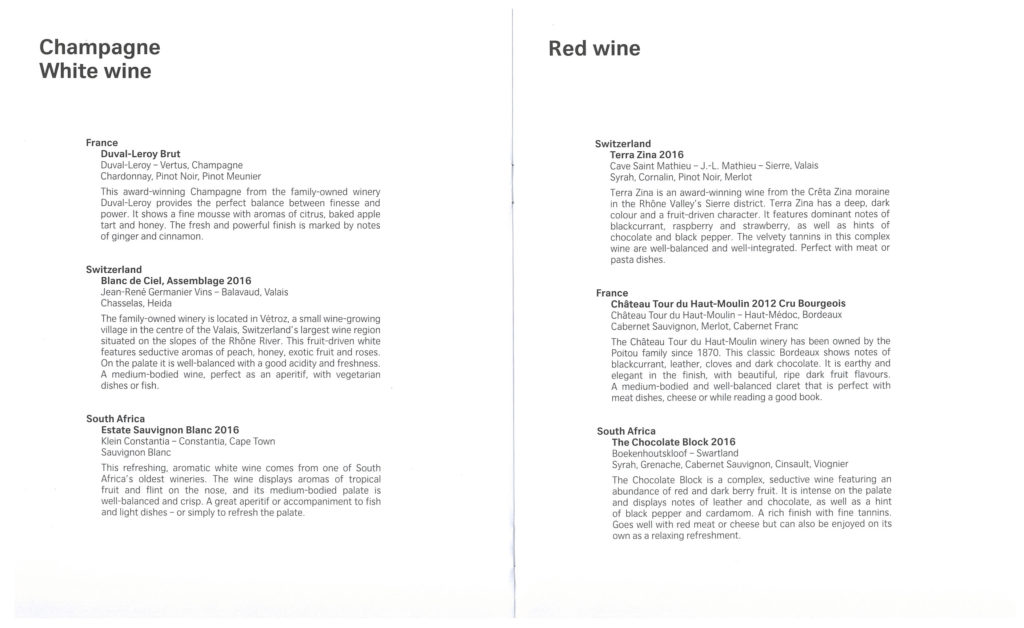
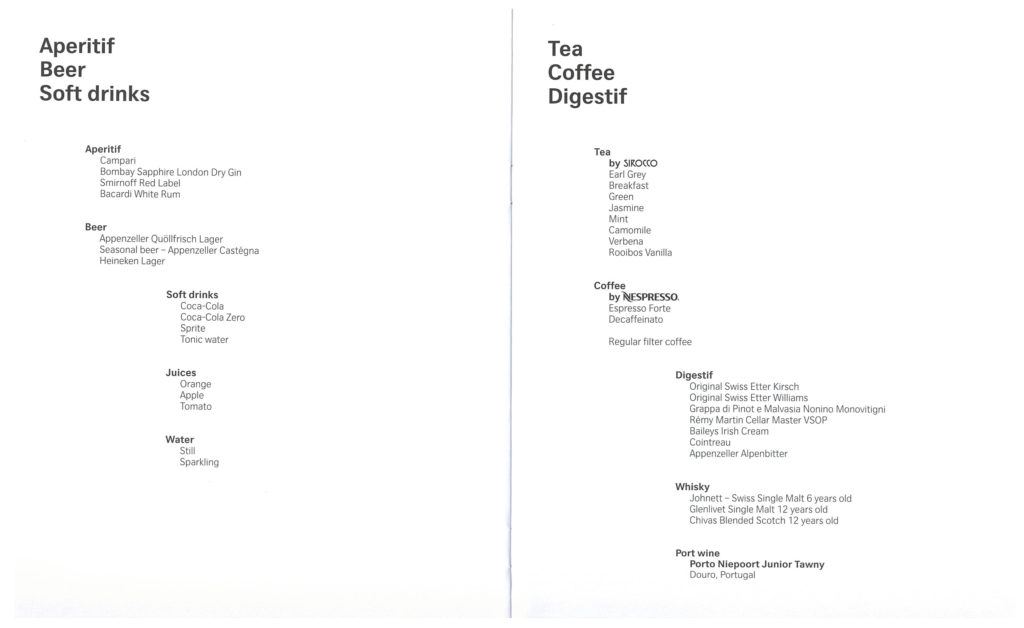
As a result, I decided to forgo cheese and dessert service on this flight as I was desperate for sleep. Dessert options were a pistachio and apricot tart with vanilla whipped cream and a selection of Swiss chocolates.
Passengers can either order or opt-out of breakfast service on cards that are collected pre-flight. Since this breakfast looked to be mostly continental, I decided to look for food in the lounge, instead.
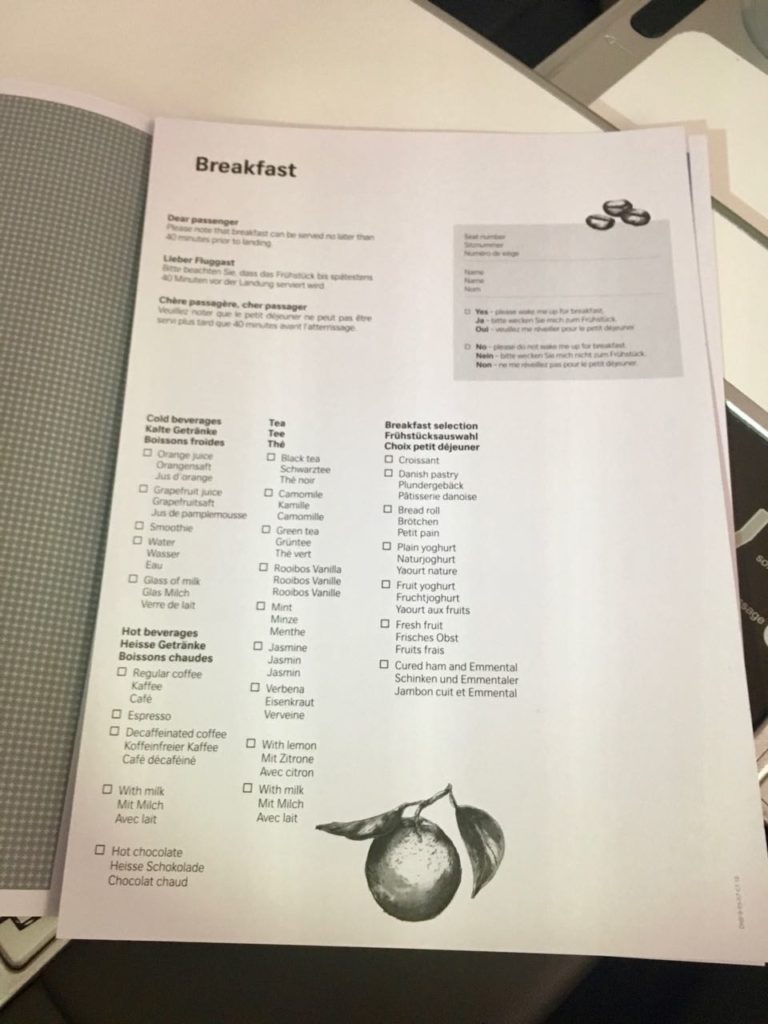
Passengers can order or opt-out of breakfast service using this card. I’d had everything here, so I decided to sleep in, instead.
It’s important to note, given the (in my opinion) extremely slow meal service on this flight, that SWIS does offer a “quicker option” on its dinner menu. That option included cold cuts and clam chowder, and can be served immediately after take-off, “allowing you more time to sleep, work or simply relax and enjoy your flight.”
This may be the option I choose, next time around. I’m happy to see more airlines offering full dinner service in lounges, particularly on flights under 8 hours.
The entertainment.
Perhaps the most disappointing aspect of this flight besides the nearly two hour dinner service, was the inflight entertainment. There just weren’t many selections available, and the screen was average, at best, perhaps similar to those offered on Delta Air Lines’ Boeing 767 DeltaOne seats.
There were maybe, maybe, 20 recognizable films to choose from. I landed on Diary of a Wimpy Kid, which I finished well before the meal service ended.
Beware of SSWISS’ Panasonic inflight wi-fi access. The airline charges CHF9.00 for 20 megabytes of internet data. Most laptops with so much as email and a browser opened to Facebook will eat through 20 megabytes of internet in about 90 seconds. This is one of the great ripoffs I have seen in all my travels.
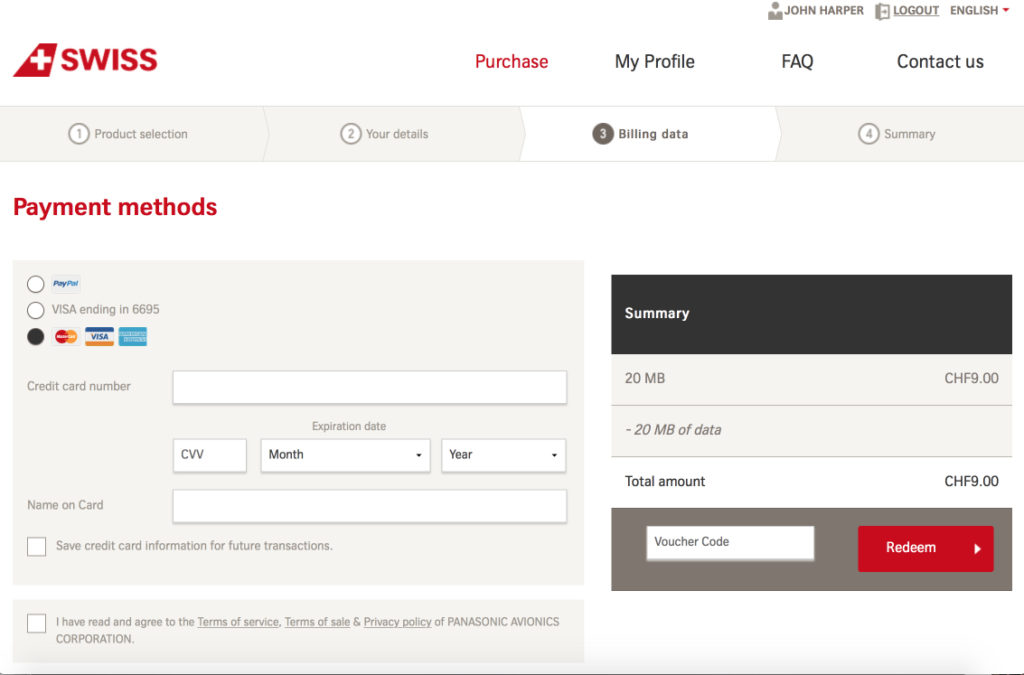
This is a terrible way to sell internet access.
Swiss now offers fully functional cellular access onboard flights. I was surprised, after plugging in my dead iPhone to charge, when I started receiving SMS messages somewhere over the Atlantic Ocean. This service, provided by AeroMobile is free upfront, though it qualifies as roaming under international cell plans. Some AeroMobile equipped aircraft also facilitate mobile data, meaning that it is conceivable to use a personal hotspot onboard, in lieu of the airline’s bogus wi-fi service.
Arrival in Zürich.

Source: Wikimedia Commons
One of the best parts of flying SWISS Air (and there are many great parts, apart from the snail’s pace meal service) is connecting via Zürich Kloten airport. The airport is gorgeous, and is so adequately staffed that immigration areas don’t even have cue lines. On this Saturday morning I was able to literally walk up to my choice of immigration counter, speak briefly with a Swiss immigration official, and continue onward to my connecting intra-European flight. The immigration process, from the time I entered the hall to the time I left, took perhaps one minute. I’m not even sure if it was a full minute.
To frame this experience a little differently, it was significantly easier to transit immigration at ZRH than it was to change terminals at Chicago O’Hare. If given the choice, I would transit immigration in Zürich five times over having to switch to the international terminal at O’Hare. This is the best immigration experience I have had anywhere in the world (though I would imagine small Scandinavian airports may be similarly equipped).
Unfortunately, the SWISS Business Lounge near my departure gate is closed through April. I was offered admission to the diminutive Aspire Lounge, which was unconscionably overcrowded due to the lounge closures, or a voucher that could be used to acquire a drink and sandwich of my choice at several cafes and bars throughout the terminal.
(For those curious, Point Me To The Plane completed a nice review of Zurich lounges a few years back.)
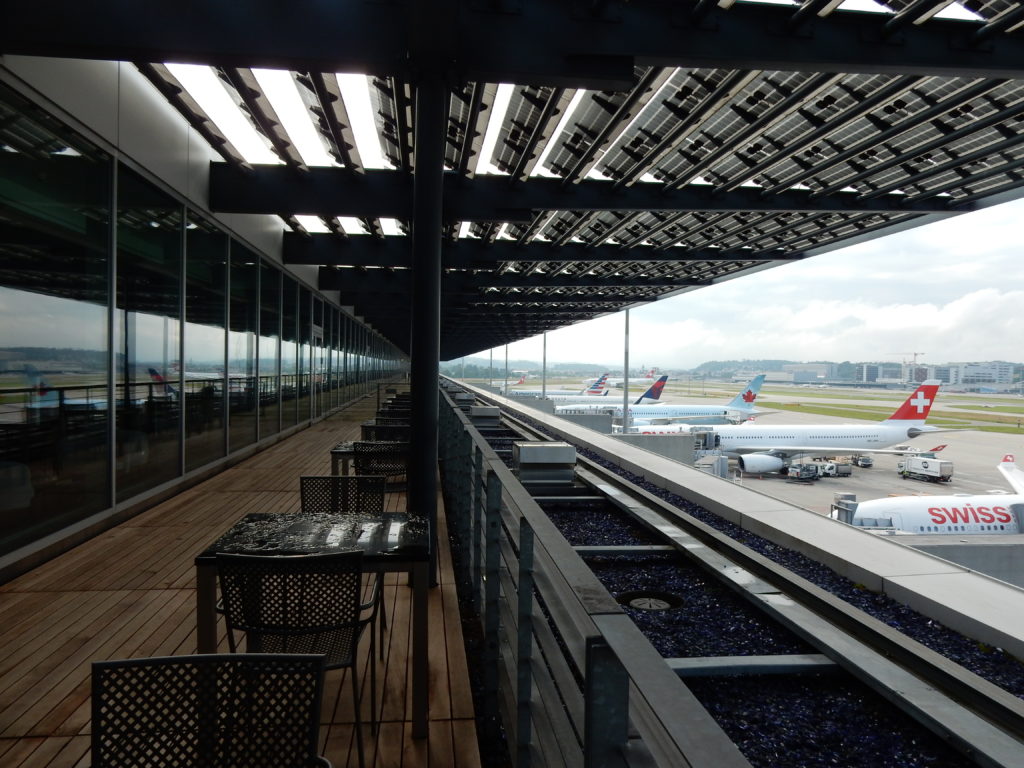
The Swissport Panorama Lounge in the international terminal offers an excellent panorama and outdoor seating. Source: Wikimedia Commons.
I could have walked to the opposite side of the terminal to access another SWISS Lounge, but given that I had 45 minutes before my connecting flight, I decided to stick in the airside center. Given, the Zürich Kloten terminal area is itself nicer than most airport lounges I’ve been to, and features public observation areas and very attractive dining and drinking spaces.
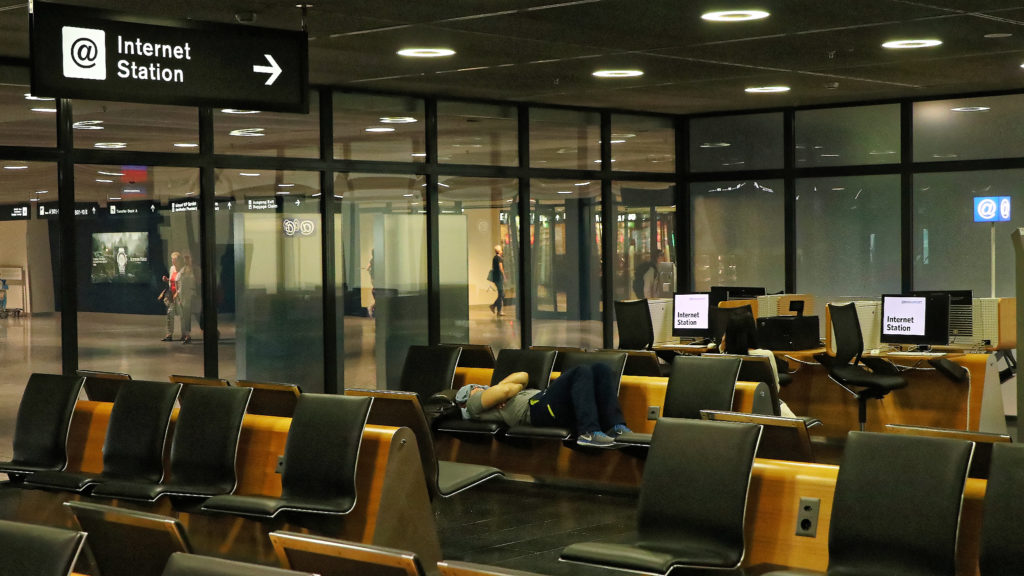
Would you rather lounge at the Delta Skyclub JFK, or this public waiting area? Zurich’s Kloten airport offers better seating and more stylish spaces than many airport lounges. Source: Wikimedia Commons.
The voucher sounded great, but was pretty miserable in practice. All of the cafes that accepted the voucher had long lines, and once I found one that didn’t, I was only allowed to order a cheese baguette. The surly barista informed me that the “airline is only willing to pay so much.”
What a bummer.
I do wish the employees onboard my incoming flight would have notified passengers of this lounge closure. If I had known, I might have stopped in the lounge inside the international terminal for a bite, instead.
From Zürich, I hopped onboard one of SWISS’ new Bombardier CS100 (read the review of that flight here), for a nearly effortless entry into Paris.
In summary.
SWISS enjoys a loyal cadre of frequent fliers. I’ve had many friends make arguments that the airline is among the best in the world. There were some surprising low spots in my service, including lackluster wi-fi and inflight entertainment choices, somewhat lumpy bed, a slow meal service and frustrating lounge situation in Zurich.
I can, however, see the potential, and really enjoyed transiting Zurich on my way to Paris. Every surface I encountered on SWISS was spotless, flight attendants were impeccably well mannered and everything just felt slick. While U.S. airlines and even other European airlines define efficiency in terms of returns to shareholders, SWISS Global’s efforts appear to minimize the effort and difficultly associated with a transatlantic crossing.
The responses below are not provided or commissioned by the bank advertiser. Responses have not been reviewed, approved or otherwise endorsed by the bank advertiser. It is not the bank advertiser's responsibility to ensure all posts and/or questions are answered.
1 comment
[…] I was needing a return home from Berlin to New York. I had arrived in Europe 9 days earlier in SWISS’ solid business class throne seat. […]